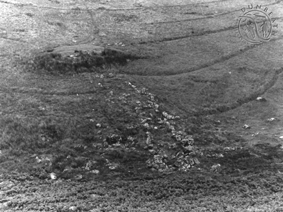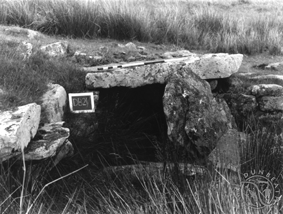Wag Mor, Raffin Burn
SITE REF: DB21/12
GRID REF: ND 0825 3680, ND 0830 3676
SITES & MONUMENTS RECORD REF: ND03NE0002, 0003, 0006
SCHEDULED ANCIENT MONUMENT
Height OD: 170m (average)
A highly complex area of ruins of prehistoric to recent structures. Much of the earlier building material appears to have been reused in later structures.
Described by the RCAHMS Inventory (1911): "On the E side of the Raffin Burn, about 2.25 miles above its junction with the Dunbeath Water at Achnaclyth, on a grassy slope beside a sheep stell, are the ruins of two or three galleried structures. The place is known as 'Wag Mor', and is within the Dunbeath deer forest. The structures are much ruined and their plans indistinct. That best preserved appears to have been an oblong building measuring some 47' in length interiorly, divided by a cross wall at 20' from the inner end. Its width seems to have been about 6' at the entrance at the outer end, and to have expanded to 8' or 9' at the opposite extremity. The walls have been built of large flat slabs and the structures have been of the galleried type."
The OS (1960) describes the structure as: "The remains of two 'wags'. That at ND 0825 3680 now appears as an oval-shaped, mutilated area measuring 24.0m N-S by 17.0m transversely, practically cleared except in the SE where there is a considerable quantity of stone. There are several orthostats in position, and the remains of an outer wall can be seen. One or two roofing slabs, not in situ, can also be seen.
"The other, at ND 0830 3677, appears as a large mutilated earth and stone mound 1.4m high at the NE end. It measures 44.0m NE-SW, being 11m wide at the S end widening to 20.0m at the N end. At the S end of the mound are the remains of an oblong building formed by a stone wall 1.0m wide. It is 11.0m long and 5.0m broad. At the N end of the mound are the remains of several rectangular buildings, one near the centre of the mound and extending right across it, is 15.0m long and --m broad, and is built into the mound on its N side, giving the wall a height of 0.7m. The NE corner of this building is covered by a large slab. The other buildings are formed by stone walls and abut each other."
The OS (1982) describes the site as: "On a gentle W-facing slope at 550ft OD is a settlement complex comprising two separate mounds, each of which contains at least one galleried structure.
"At 'A' (ND 0825 3680) numerous large stones protrude through the turf capping; some are loose, others are earthfast and upright. These form no identifiable pattern except along the E side, where a discontinuous line of boulders defines an inner face some 8.4m long. At a distance of about 1.0m from the face is a line of four orthostats, up to 0.9m high, which appear to be more or less in situ; the S orthostat has its lintel lying displaced against it. This is probably the remains of the E side of a rectangular 'wag' of unknown size, though the shape of the mound suggests one or more buried structures.
"On 'B' (ND 0830 3676), a rectangular 'wag' 22.0m long and about 4.2m wide internally occupies the lower SW end of the mound. The oversailing inner face survives to a height of 1.0m in the NE; elsewhere it is reduced to a single course of stones or obscured by tumble. At least ten orthostats can be identified up to a height of 0.8m. The position of the entrance cannot now be determined. A later wall, probably early-modern, encroaches upon the NE part of the wag; other rectilinear features surmount the highest point on the mound, effectively obscuring details of an earlier structure of unknown shape and size which must have existed here.
"Low, boulder-faced walls extend between mounds A and B, forming an enclosure. They are sunk into the peat and are of at most random construction; as such they are more likely to be contemporary with the 'wags' than with the early-modern phase."
the site is obviously one of multiple occupation. There are at least two of the galleried structures known in this region as 'wags'. It is possible that some of the other turf-covered remains could be of hut circles. One possibility is that the area was used as a shieling ground in more recent centuries and that some of the cell-like, sub-rectangular or circular compartments are the footings of shieling huts or bothies on top of the earlier structures. The area may have again become fertile through use as a shieling ground (there are traces of 'improved' land in the vicinity), and for a time becoming permanently settled, leaving the uppermost, rectangular, dry-stone foundations of long buildings.


